| |
|
|
| |
Fish the riffles and runs for late Summer fun.
Fri 22nd February, 2013
|
|
|
|
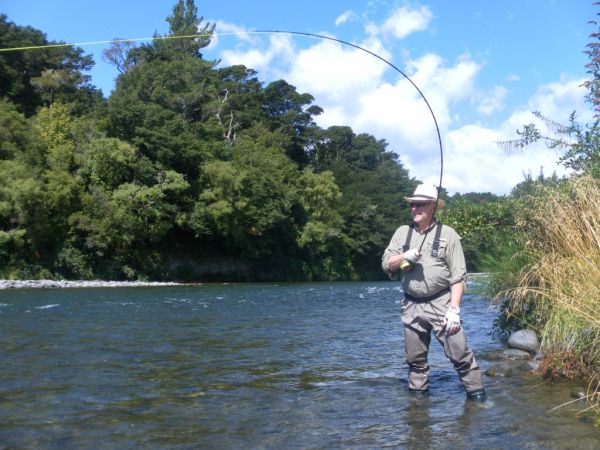
Its been a long hot summer and although autumn is just around the corner its still very much a case of summer tactics for success on the Tongariro. Think oxygen and cool water and you'll find the fish.
Riffles are a great place too start. In these shallower stretches rocks and stones moved from further up often collect on the river bed and as the water passes over them the resulting turbulence helps promote the gas exchange that we call oxygenation. Trout use their gills to extract this dissolved oxygen {dO2} from the water but the amount of dO2 available to them is partly influenced by the water temperature. In summer as temperatures climb the water in the slower parts of the river heats up and dO2 levels can fall. This can affect their behavior and especially their feeding habits. On hot sunny days trout will actively seek out cooler oxygen rich water and are often found holding in riffles. Many of the invertebrates they regularly feed on spend most of the aquatic stage of their life cycle in this environment. Caddis in particular love these faster, shallower stretches of river, something to bear in mind because anglers sometimes fish the larvae imitations in water that’s too slow. So riffles are often good places to find trout and the insects they eat … but what else do they have to offer?
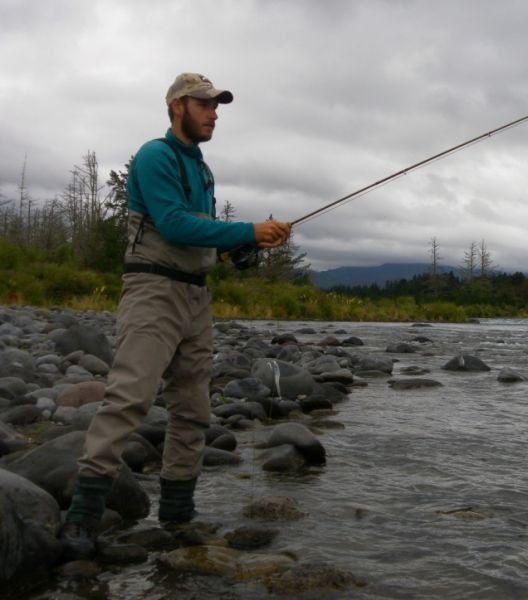
Guides will often put clients in riffles and there are a number of good reasons why. Riffles are generally much more user friendly than pools especially if you’re a complete novice and have never fly fished before. There is no need for long leaders and heavy bombs so learning to cast with a lighter set-up is much easier. Unlike a pool, riffles flow at a fairly uniform speed so you need very little mending to achieve a good drift and because the water is shallow you don’t waste time waiting for the nymphs to sink to the river-bed, this means you’re flies are fishing effectively for longer. Trout are less likely to be spooked by the fly line because its silhouette is broken up by the choppy water. So riffles are a great place to experiment with the dry fly for the first time. However a big fluffy indicator doesn't go down to well here so if you're nymphing use something else. The dry and dropper always works well in riffles and is my first choice when ever I'm fishing this kind of water.
Trout are also easier to sneak up on in riffles. The books written by anglers like Vince Marinaro or Brian Clarke and John Goddard have demonstrated how trout view the outside world through a circular "window" surrounded by mirrors. The radius of this window gets smaller the nearer the surface the trout is lying and conversely increases the deeper the fish swims. For instance if the fish is lying at a depth of six inches its view of the outside world is confined to an area at the surface about the size of a saucer. But if its six feet down in a deep pool this increases to a radius of over five feet. This helps explain why, with a careful approach, its possible to get up close to fish holding in shallower water without spooking them. Which in turn makes life a lot easier as far as casting and presentation is concerned. We all have favorite places along the river, banker spots where we nearly always hook up. Thinking about it only one of mine is a pool, the others are all riffles or runs. Next time don't walk past ... give them a try ... you'll have a lot of fun.
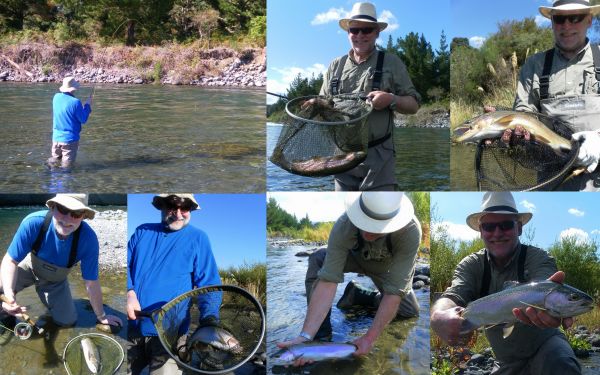 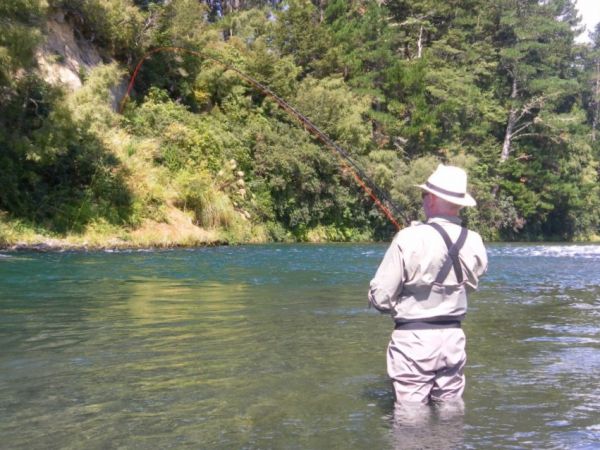 I had the pleasure of spending a couple of days on the river with Norwegian angler Tore Aalberg. Tore loves fishing the Tongariro and annually makes the long pilgrimage around the same time. Last trip he he took a couple of Deer Hair Cicada flies back with him. The two brown trout in the last report were both caught on one ... despite the fact they don't have cicadas anywhere in Norway. This time the Tongariro browns got the better of him. He hooked up early nymphing the Cliff Pool but lost it in the strong current of the tail. Then during the afternoon played another in the middle river which ran him all over the pool and had him on the backing as it steamed off upriver. He managed to get the fly line back on the reel but lost the fish in the shallows just when he was gaining the upper hand. I had the pleasure of spending a couple of days on the river with Norwegian angler Tore Aalberg. Tore loves fishing the Tongariro and annually makes the long pilgrimage around the same time. Last trip he he took a couple of Deer Hair Cicada flies back with him. The two brown trout in the last report were both caught on one ... despite the fact they don't have cicadas anywhere in Norway. This time the Tongariro browns got the better of him. He hooked up early nymphing the Cliff Pool but lost it in the strong current of the tail. Then during the afternoon played another in the middle river which ran him all over the pool and had him on the backing as it steamed off upriver. He managed to get the fly line back on the reel but lost the fish in the shallows just when he was gaining the upper hand.
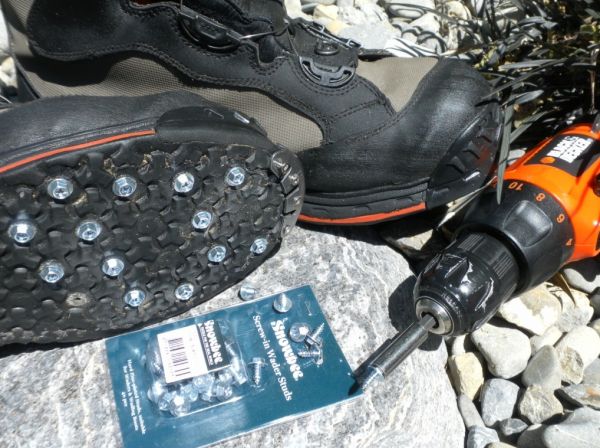
HOW TO TWEAK YOUR WADING BOOTS.
With the long hot spell set to continue for at least another week the lack of any significant rain and the resulting low river levels mean things are getting pretty slippery out there. Last time we looked at wading and although I try and stay out of the water where ever possible there are times when we have to get in. Wading at this time of year on slime covered rocks can be treacherous and it’s essential to wear the right footwear to maximize grip. With felt banned it comes down to rubber with studs or rubber without studs. Personally I find the so called sticky soles any thing but on slippery Tongariro cannon balls, so I prefer to use screw in studs. There are a number of reasons why.
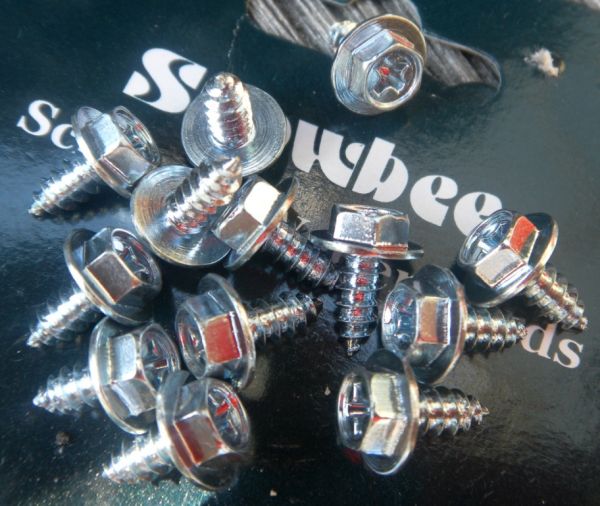 There’s no doubt the Tongariro is tough on boots, I get through at least a couple of pairs a year. If I didn’t tweak the boots to improve their durability I’m sure I’d get through a lot more. There’s no doubt the Tongariro is tough on boots, I get through at least a couple of pairs a year. If I didn’t tweak the boots to improve their durability I’m sure I’d get through a lot more.
As soon as I take them out of the box I stud the sole and heel. I prefer Simms boots but their own brand studs while good are expensive, there are alternatives. Snowbee sell screw in wading studs in packs of forty for around ten bucks. If you hunted around the Internet you could probably get them cheaper than that because they appear to be ordinary hex head sheet screws. Applying them to your boots couldn’t be easier. The universal adapter that comes with most drills is a perfect fit for the screw heads and makes screwing them in a doddle. But a little tip … replace worn studs before the heads wear down completely or you won't be able to unscrew them with the drill.
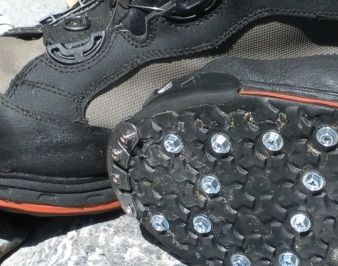 The addition of studs not only improves your boots bite on wet slippery rocks but also helps prevent the bottoms of your wading boots from quickly wearing smooth in the abrasive environment of the Tongariro river. I also add a steel toe plate to the front of the boot. These are available from most shoe repair shops or some motor cycle accessory stores. I find these are easier to fit after I’ve worn the boots a few times just as the front of the sole starts to show signs of wear. Without this added protection this part of the boot quickly wears thin and delaminates. The addition of studs not only improves your boots bite on wet slippery rocks but also helps prevent the bottoms of your wading boots from quickly wearing smooth in the abrasive environment of the Tongariro river. I also add a steel toe plate to the front of the boot. These are available from most shoe repair shops or some motor cycle accessory stores. I find these are easier to fit after I’ve worn the boots a few times just as the front of the sole starts to show signs of wear. Without this added protection this part of the boot quickly wears thin and delaminates.
The plate comes pre-drilled with four countersunk holes and you simply screw them on.
But there are some disadvantages. On dry hard rocks studs are hopeless and there is also the noise factor to consider, although I don’t think that’s as much of an issue as far as the Tongariro is concerned. On this river trout are exposed to all kinds of disturbance on a daily basis. Rafts, canoes, walkers, mountain bikers, swimmers and of course fly fishermen. One of the most consistent possies on the river is just below the SH 1 road bridge ... a delightfully tranquil spot to get away from it all!
If the fish in the Tongariro became overly spooky every time they heard a noise they’d starve to death. Providing you wade sensibly the fact that you’re wearing studded boots shouldn’t make too much difference to your catch rate. Even with studs I still take the odd unscheduled dip but without them I'd spend more time in the river than the trout ... so despite the drawbacks I'll stick with studs.
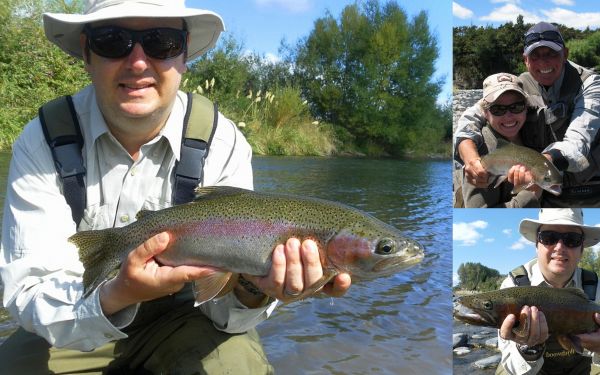
Peter Gibbinson and his lovely wife Avril were on their first trip to New Zealand. If you're a coarse fisherman you'll probably recognize the surname because Peter's dad Jim is a living legend among carp anglers. He's been involved in the development of modern carp fishing techniques and equipment for over 45 yrs and is still a prolific writer. Although Peter has a busy career in the banking industry in Singapore he shares his fathers passion and fishes whenever he can. A few years ago he bought his own 35 acre gravel-pit back in the U.K which is used by a fifty member syndicate and has already thrown up huge carp, double figure pike and specimen tench. It was their first serious attempt at fly fishing and I'm happy to report they loved it ... more Tongariro converts.
Now the last of Grant's Irish gags :
Ronnie walks into Sandy's barn and catches him dancing naked in front of a tractor.
Ronnie says, "Oh, no, Sandy, what ya doing?"
Sandy says, "Well, me and Kate haven't been getting on in the bedroom lately and the therapist recommended I do something sexy to a tractor.
Paddy says to Mick, "Christmas is on a Friday this year"
Mick says "Let's hope it's not the 13th."
Paddy's in the bathroom and Murphy shouts to him. "Did you find the shampoo?"
Paddy says, "Yes but it's for dry hair and I've just wet mine."
"Paddy says to Mick - I'm ready for a holiday, only this year I'm going to do it a bit different.
3 years ago I went to Spain and Mary got pregnant.
2 years ago I went to Italy and Mary got pregnant.
Last year I went to Majorca and Mary got pregnant."
Mick asks - So what are you going to do this year?."
Paddy replies, - I'll take her with me!"
It looks as if we may get some rain at the beginning of March but whether it will be enough to make a difference is anyone's guess. The ground moisture content {or more precisely the lack of any} has definitely affected this years cicada hatch and so far it has been a disappointing non-event. In fact I've seen very few fish rising to anything in comparison to previous years ... may be I'm on the river at the wrong times. Still lots of scrappy juvenile trout around and Peter took eleven from one small run in no time at all. There are browns in the usual middle and upper river pools but I haven't scored yet around town. Best nymphs Hare and Copper flash-backs, small Pheasant Tails and check out a useful all-rounder called the Rainbow Warrior.
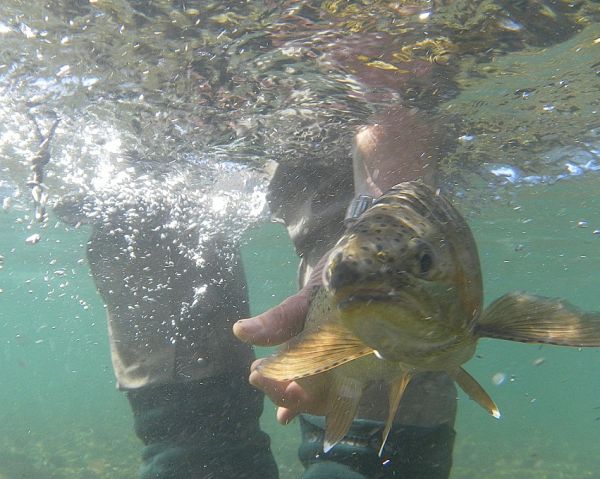
Tight lines guys
Mike |
|
|
| Back to Top |
|
|
|
|
|
|
|